A Comprehensive Study of the Use of LoRa in the Development of Smart Cities
Abstract
:1. Introduction
2. Background
2.1. Dimensions and Projections of Smart Cities
2.2. IoT Technologies for Smart Cities
2.3. Parameters of Transmission for LoRa
- High sensitivity in receiving data (End nodes: Up to −137 dBm, Gateways: Up to −142 dBm)
- High tolerance to interferences: resistant to the Doppler effect, multi-path fading, and signal weakening
- Strong indoor penetration. High SF, up to 20 dB penetration
- Low consumption of energy, approximately 10 years of battery lifetime
- Low range of coverage, between 10 to 20 km
- Reduced data transfer
- Point-to-point connection and Gateway connection
- High Scalability. Only one gateway can cover a radius of 15 km
- Two models of service: network provider or private network
3. Materials and Methods
3.1. Stage 1: Identification
3.1.1. Study Selection
3.1.2. Inclusion and Exclusion Criteria
3.1.3. Manual Search
3.1.4. Removal of Duplicates
3.2. Stage 2: Screening
Titles and Abstracts
3.3. Stage 2: Eligibility Analysis
Full-Text Reading
3.4. Stage 4: Inclusion
Data Extraction
4. Results of the Analysis of the Selected Works
4.1. Analysis of the Application Layer
4.1.1. Agriculture
4.1.2. Healthcare
4.1.3. Traffic Control and Transportation
4.1.4. Energy
4.1.5. Environment
4.1.6. Waste Management
4.2. Analysis of the Network and Transport Capabilities
4.2.1. Data Layer
4.2.2. Coverage of LoRa in IoT Applications
4.3. Analysis of the Device Layer
4.3.1. Sensors
4.3.2. Nodes
- Point to point: the node does not require an intermediary device and can communicate directly with other nodes.
- Mesh: a gateway is in charge of coordinating the communication between nodes in the network. It has a limited capacity of 250 nodes.
- Class A: Offers greater energy savings. It is in listening mode after sending data to the gateway.
- Class B: Nodes have default reception windows with the gateway
- Class C: Presents the lowest energy savings
- Active mode: At its full capacity, it consumes about 170 mA.
- Sleep mode: A real-time clock (RTC) is active for synchronization. In this mode, ESP8266 maintains data connection and does not require re-establishing the connection again. In this mode, the chip consumes between 0.6 mA and 1 mA.
- Deep Sleep: The RTC is not operational. Unsaved data are lost. In this mode, the device consumes about 20 uA.
5. Discussion
5.1. Smart City Strategies Using IoT–LoRa
5.2. Social Contribution
5.3. Industrial Contribution
5.4. Research Contribution
5.5. Challenges of LoRa in Smart Cities
5.5.1. Security and Privacy
5.5.2. IoT Analytics
5.6. Strengths, Weaknesses, Opportunities, and Threats Analysis of LoRa in Smart City Applications
5.7. Impact of LoRa Research Proposals in the Smart City Initiative
5.7.1. Future Trends of LoRa Proposals in Smart City Based on Circular Economy
5.7.2. Data Integration Hypothesis
5.7.3. LoRa Proposals for the Generation of New Business Opportunities
5.7.4. LoRa Proposals in the Building of Smart Cities
5.7.5. Aspects to Consider to Develop IoT Solutions that Contribute to the Development of Smart City Circularity.
6. Conclusions
Author Contributions
Funding
Acknowledgments
Conflicts of Interest
References
- United Nations. New Urban Agenda. 2016. Available online: http://habitat3.org/ (accessed on 15 October 2019).
- Gravagnuolo, A.; Angrisano, M.; Girard, L.F. Circular Economy Strategies in Eight Historic Port Cities: Criteria and Indicators Towards a Circular City Assessment Framework. Sustainability 2019, 11, 3512. [Google Scholar] [CrossRef]
- Hernandez, J.R. Sustainable Product-Service Systems and Circular Economies. Sustainability 2019, 11, 5383. [Google Scholar] [CrossRef]
- Mekki, K.; Bajic, E.; Chaxel, F.; Meyer, F. A comparative study of LPWAN technologies for large-scale IoT deployment. ICT Express 2019, 5, 1–7. [Google Scholar] [CrossRef]
- United Nations Department of Economic and Social Affairs. 68% of the World Population Projected to Live in Urban Areas by 2050. 2019. Available online: https://www.un.org/development/desa/en/news/population/2018-revision-of-world-urbanization-prospects.html (accessed on 23 September 2019).
- World Health Organization. Ageing and Health. 2018. Available online: https://www.who.int/news-room/fact-sheets/detail/ageing-and-health (accessed on 15 August 2019).
- Worldbank. Cities and Climate: An Urgent Agenda. 2018. Available online: http://siteresources.worldbank.org/INTUWM/Resources/340232-1205330656272/4768406-1291309208465/PartIII.pdf (accessed on 23 September 2019).
- Intel. Accelerating the Future: The Economic Impact of the Emerging Passenger Economy. 2017. Available online: https://newsroom.intel.com/newsroom/wp-content/uploads/sites/11/2017/05/passenger-economy.pdf?cid=em-elq-26916&utm_source=elq&utm_medium=email&utm_campaign=26916&elq_cid=1494219 (accessed on 14 August 2019).
- Alvarado López, R.A. Ciudad inteligente y sostenible: Hacia un modelo de innovación inclusiva. Rev. Tecnol. Soc. 2018, 7, 299. [Google Scholar] [CrossRef]
- Albino, R.M.; Berardi, V.; Dangelico, U. Smart Cities: Definitions, Dimensions, Performance, and Initiatives. J. Urban Technol. 2015, 22, 3–21. [Google Scholar] [CrossRef]
- Bouskela, M.; Casseb, M.; Bassi, S.; De Luca, C.F. La Rutahacia las Smartcities: Migrando de una Gestión Tradicional a la Ciudad Inteligente; Inter-American Development Bank: Washington, DC, USA, 2016. [Google Scholar]
- Gartner. Leading the IoT. 2015. Available online: https://www.gartner.com/imagesrv/books/iot/iotEbook_digital.pdf (accessed on 14 August 2019).
- Statista. Connected Things Smart Cities Utilities Sector 2015–2018|Statista. 2019. Available online: https://www.statista.com/statistics/423063/smart-cities-connected-things-installed-base-utilities-sector/ (accessed on 15 August 2019).
- Gartner. Gartner Says Worldwide IoT Security Spending Will Reach $1.5 Billion in 2018. 2018. Available online: https://www.gartner.com/en/newsroom/press-releases/2018-03-21-gartner-says-worldwide-iot-security-spending-will-reach-1-point-5-billion-in-2018 (accessed on 15 August 2019).
- McKinsey. Disruptive Technologies: Advances that will Transform Life, Business, and the Global Economy|McKinsey. 2019. Available online: https://www.mckinsey.com/business-functions/digital-mckinsey/our-insights/disruptive-technologies (accessed on 15 August 2019).
- Abate, F.; Carratu, M.; Liguori, C.; Paciello, V. A low cost smart power meter for IoT. Measurement 2019, 136, 59–66. [Google Scholar] [CrossRef]
- ITU. IoT Standards, Part II: 3 Gpp Standards. 2018. Available online: https://www.itu.int/en/ITU-D/Regional-Presence/AsiaPacific/Documents/Events/2018/IoTBDG/7.IoTStandardsPartII SamiTabbane.pdf (accessed on 23 September 2019).
- Paredes-Parra, J.M.; García-Sánchez, A.J.; Mateo-Aroca, A.; Molina-Garcia, A. An Alternative Internet-of-Things Solution Based on LoRa for PV Power Plants: Data Monitoring and Management. Energies 2019, 12, 881. [Google Scholar] [CrossRef]
- LoRa Alliance. What Is the LoRaWAN Specification. 2019. Available online: https://lora-alliance.org/resource-hub/what-lorawanr (accessed on 23 September 2019).
- ITU. Y.2060: Overview of the Internet of Things. 2019. Available online: https://www.itu.int/rec/T-REC-Y.2060-201206-I/es (accessed on 23 September 2019).
- Moher, D.; Liberati, A.; Tetzlaff, J.; Altman, D.G. Preferred Reporting Items for Systematic Reviews and Meta-Analyses: The PRISMA Statement. PLoS Med. 2009, 6, e1000097. [Google Scholar] [CrossRef]
- Dos Santos, U.J.L.; Pessin, G.; da Costa, C.A.; da Rosa Righi, R. AgriPrediction: A Proactive Internet of Things Model to Anticipate Problems and Improve Production in Agricultural Crops. In Computers and Electronics in Agriculture; Applied Computing Graduate Program: Unisinos, Brazil, 2018. [Google Scholar]
- Adriano, J.D.; Mendes, Y.C.T.; Marcondes, G.A.B.; Furtado, V.; Rodrigues, J.J.P.C. An IoT Sensor Mote for Precision Agriculture with Several MAC Layer Protocols Support. In Proceedings of the International Conference on Information and Communication Technology Convergence (ICTC), Jeju, Korea, 17–19 October 2018; pp. 684–688. [Google Scholar]
- Zamora-Izquierdo, M.A.; Santa, J.; Martínez, J.A.; Martínez, V.; Skarmeta, A.F. Smart farming IoT platform based on edge and cloud computing. Biosyst. Eng. 2019, 177, 4–17. [Google Scholar] [CrossRef]
- Kim, S.; Lee, M.; Shin, C. IoT-Based Strawberry Disease Prediction System for Smart Farming. Sensors 2018, 18, 4051. [Google Scholar] [CrossRef]
- Food and Agriculture Organization of the United Nations. FAO—News Article: 2050: A Third More Mouths to Feed. 2018. Available online: http://www.fao.org/news/story/en/item/35571/icode/ (accessed on 17 August 2019).
- Park, S.; Kwon, R.; Yun, S.; Ganser, J.; Kim, H.; Anthony, S. Forestry Monitoring System Using Lora and Drone. In ACM International Conference Proceeding Series; ACM: New York, NY, USA, 2018. [Google Scholar]
- Zhao, W.; Lin, S.; Han, J.; Xu, R.; Hou, L. Design and Implementation of Smart Irrigation System Based on LoRa. In Proceedings of the IEEE Globecom Workshops (GC Wkshps), Singapore, 4–8 December 2017; pp. 1–6. [Google Scholar]
- Niswar, M.; Wainalang, S.; Ilham, A.A.; Zainuddin, Z.; Fujaya, Y.; Muslimin, Z. IoT-based water quality monitoring system for soft-shell crab farming. In Proceedings of the IEEE International Conference on Internet of Things and Intelligence System (IOTAIS), Bali, Indonesia, 1–3 November 2018; pp. 6–9. [Google Scholar]
- Sardar, M.S.; Yi, Y.; Xue-fen, W.; Huang, J.; Zhang, J.; Qin, X. Experimental Analysis of LoRa CSS Wireless Transmission Characteristics for Forestry Monitoring and Sensing. In Proceedings of the International Symposium in Sensing and Instrumentation in IoT Era (ISSI), Shanghai, China, 6–7 September 2018; pp. 1249–1254. [Google Scholar]
- Mdhaffar, A.; Chaari, T.; Larbi, K.; Jmaiel, M.; Freisleben, B. IoT-based health monitoring via LoRaWAN. In Proceedings of the 17th International Conference on Smart Technologies, Ohrid, Macedonia, 6–8 July 2017; pp. 519–524. [Google Scholar]
- Nugraha, A.T.; Hayati, N.; Suryanegara, M. The experimental trial of LoRa system for tracking and monitoring patient with mental disorder. In Proceedings of the International Conference on Signals and Systems (ICSigSys), Bali, Indonesia, 1–3 May 2018; pp. 191–196. [Google Scholar]
- Shreepriya, S.; Bottia, A.; Du, Y. We Care: Integrated Helping System for People with Physical Limitations. In HCI International 2018—Posters’ Extended Abstracts; Springer: Cham, Switzerland, 2018; pp. 89–94. [Google Scholar]
- Wan, J.; Al-awlaqi, M.A.; Li, M.; O’Grady, M.; Gu, X.; Wang, J.; Cao, N. Wearable IoT enabled real-time health monitoring system. EURASIP J. Wirel. Commun. Netw. 2018, 1, 298. [Google Scholar] [CrossRef]
- Kharel, J.; Reda, H.T.; Shin, S.Y. Fog Computing-Based Smart Health Monitoring System Deploying LoRa Wireless Communication. IETE Tech. Rev. 2019, 36, 69–82. [Google Scholar] [CrossRef]
- Tat, Y.T.; Liu, Y.; Zhu, H.; Tsang, K.F. Feasiblity studies on smart pole connectivity based on lpwa iot communication platform for industrial applications. In Proceedings of the 44th Annual Conference of the IEEE Industrial Electronics Society, Washington, DC, USA, 21–23 October 2018; pp. 4131–4134. [Google Scholar]
- Ali Kumar, D.N.S.K.P.; Au, T.W.; Suhaili, W.S. Smart LED Street Light Systems: A Bruneian Case Study. In Multi-Disciplinary Trends in Artificial Intelligence; Springer: Cham, Switzerland, 2017; pp. 370–379. [Google Scholar]
- Nor, R.F.A.M.; Zaman, F.H.K.; Mubdi, S. Smart traffic light for congestion monitoring using LoRaWAN. In Proceedings of the 8th Control and System Graduate Research Colloquium (ICSGRC), Shah Alam, Malaysia, 4–5 August 2017; pp. 132–137. [Google Scholar]
- Huang, Y.; Chen, Y.-C.; You, C.-W.; Wu, D.-X.; Chen, Y.-L.; Hua, K.-L.; Hsu, J.Y.-J. Toward an easy deployable outdoor parking system—Lessons from long-term deployment. In Proceedings of the IEEE International Conference on Pervasive Computing and Communications (PerCom), Kona, HI, USA, 13–17 March 2017; pp. 227–236. [Google Scholar]
- Tsai, M.-F.; Kiong, Y.C.; Sinn, A. Smart service relying on Internet of Things technology in parking systems. J. Supercomput. 2018, 74, 4315–4338. [Google Scholar] [CrossRef]
- Tanaka, M.S.; Miyanishi, Y.; Toyota, M.; Murakami, T.; Hirazakura, R.; Itou, T. A study of bus location system using LoRa: Bus location system for community bus ‘notty’. In Proceedings of the 6th Global Conference on Consumer Electronics (GCCE), Nagoya, Japan, 24–27 October 2017; pp. 1–4. [Google Scholar]
- James, J.G.; Nair, S. Efficient, real-time tracking of public transport, using LoRaWAN and RF transceivers. In Proceedings of the IEEE Region 10 Conference (TENCON), Penang, Malaysia, 5–8 November 2017; pp. 2258–2261. [Google Scholar]
- Zguira, Y.; Rivano, H.; Meddeb, A. Internet of Bikes: A DTN Protocol with Data Aggregation for Urban Data Collection. Sensors 2018, 18, 2819. [Google Scholar] [CrossRef] [PubMed]
- Andersen, A.; Karlsen, R.; Yu, W. Green Transportation Choices with IoT and Smart Nudging. In Handbook of Smart Cities: Software Services and Cyber Infrastructure; Maheswaran, M., Badidi, E., Eds.; Springer: Cham, Switzerland, 2018; pp. 331–354. [Google Scholar]
- Srivatchan, N.S.; Rangarajan, P. A Novel Low-Cost Smart Energy Meter Based on IoT for Developing Countries’ Micro Grids. In Concurrency Computation; Department of Electrical & Electronics Engineering, Sathyabama Institute of Science and Technology: Chennai, India, 2018. [Google Scholar]
- Haiahem, R.; Ghazel, C.; Saidane, L.A.; Boumerdassi, S. Surveying and Analyzing Urban Environment Approaches of Air Quality Monitoring. In Mobile, Secure, and Programmable Networking; Springer: Cham, Switzerland, 2019; pp. 1–12. [Google Scholar]
- World Health Organization. WHO Air Pollution. 2019. Available online: https://www.who.int/airpollution/en/ (accessed on 17 August 2019).
- Marques, G.; Ferreira, C.R.; Pitarma, R. Indoor Air Quality Assessment Using a CO2 Monitoring System Based on Internet of Things. J. Med. Syst. 2019, 43, 67. [Google Scholar] [CrossRef]
- Chung, C.; Peng, I.; Yeh, J. Intelligent Classification and Environment Monitoring System Combined with LoRa Wireless Transmission Technology. In Proceedings of the International Symposium on Computer, Consumer and Control (IS3C), Taichung, Taiwan, 6–8 December 2018; pp. 173–176. [Google Scholar]
- Marques, P.; Manfroi, D.; Deitos, E.; Cegoni, J.; Castilhos, R.; Rochol, J.; Pignaton, E.; Kunst, R. An IoT-based smart cities infrastructure architecture applied to a waste management scenario. Ad Hoc Netw. 2019, 87, 200–208. [Google Scholar] [CrossRef]
- Drenoyanis, A.; Raad, R.; Wady, I.; Krogh, C. Implementation of an IoT Based Radar Sensor Network for Wastewater Management. Sensors 2019, 19, 254. [Google Scholar] [CrossRef]
- Susanto, R.; Anthony, J. Comparison of three LoRa devices and its application on street light monitoring system. IOP Conf. Ser. Earth Environ. Sci. 2018, 195, 012066. [Google Scholar] [CrossRef]
- Rachmani, A.F.; Zulkifli, F.Y. Design of IoT Monitoring System Based on LoRa Technology for Starfruit Plantation. In Proceedings of the Region 10 Conference (TENCON), Jeju, Korea, 28–31 October 2018; pp. 1241–1245. [Google Scholar]
- Zguira, Y.; Rivano, H.; Meddeb, A. For an efficient internet of bikes: A DTN routing protocol based on data aggregation approach. In Proceedings of the 15th ACM International Symposium on Performance Evaluation of Wireless Ad Hoc, Sensor, and Ubiquitous Networks, Montreal, QC, Canada, 28 October–2 November 2018; pp. 17–25. [Google Scholar]
- Li, T.; Xia, M.; Chen, J.; Zhao, Y.; De Silva, C. Automated Water Quality Survey and Evaluation Using an IoT Platform with Mobile Sensor Nodes. Sensors 2017, 17, 1735. [Google Scholar] [CrossRef]
- Augustin, A.; Yi, J.; Clausen, T.; Townsley, W.M. A Study of LoRa: Long Range & Low Power Networks for the Internet of Things. Sensors 2016, 16, 1466. [Google Scholar] [CrossRef]
- Catherwood, P.A.; Steele, D.; Little, M.; McComb, S.; McLaughlin, J. A Community-Based IoT Personalized Wireless Healthcare Solution Trial. IEEE J. Transl. Eng. Heal. Med. 2018, 6, 1–13. [Google Scholar] [CrossRef] [PubMed]
- Nugraha, A.T.; Wibowo, R.; Suryanegara, M.; Hayati, N. An IoT-LoRa System for Tracking a Patient with a Mental Disorder: Correlation between Battery Capacity and Speed of Movement. In Proceedings of the 7th International Conference on Computer and Communication Engineering (ICCCE), Kuala Lumpur, Malaysia, 19–20 September 2018; pp. 198–201. [Google Scholar]
- Khoa, A.T.; Man, M.M.; Nguyen, T.-Y.; Nguyen, V.; Nam, H.N. Smart Agriculture Using IoT Multi-Sensors: A Novel Watering Management System. J. Sens. Actuator Netw. 2019, 8, 45. [Google Scholar] [CrossRef]
- Valach, A.; MacKo, D. Exploration of the LoRa Technology Utilization Possibilities in Healthcare IoT Devices. In Proceedings of the 16th IEEE International Conference on Emerging eLearning Technologies and Applications, Stary Smokovec, Slovakia, 15–16 November 2018; pp. 623–628. [Google Scholar]
- Wu, F.; Wu, T.; Yuce, M.R. An Internet-of-Things (IoT) Network System for Connected Safety and Health Monitoring Applications. Sensor 2018, 19, 21. [Google Scholar] [CrossRef] [PubMed]
- Rossi, M.; Tosato, P. Energy neutral design of an IoT system for pollution monitoring. In Proceedings of the Workshop on Environmental, Energy, and Structural Monitoring Systems (EESMS), Milan, Italy, 24–25 July 2017. [Google Scholar]
- Alahi, M.E.E.; Pereira-Ishak, N.; Mukhopadhyay, S.C.; Burkitt, L. An Internet-of-Things Enabled Smart Sensing System for Nitrate Monitoring. IEEE Internet Things J. 2018, 5, 4409–4417. [Google Scholar] [CrossRef]
- Chen, W.-E.; Chang, M.-Y.; Chou, K.-L.; Shi, J.-Q. An IoT Platform for Smart Plant Care. In IoT as a Service; Springer: Cham, Switzerland, 2018; pp. 101–107. [Google Scholar]
- Ma, Y.-W.; Chen, J.-L. Toward intelligent agriculture service platform with lora-based wireless sensor network. In Proceedings of the 4th IEEE International Conference on Applied System Innovation (ICASI), Chiba, Japan, 13–17 April 2018; pp. 204–207. [Google Scholar]
- Zougmore, T.-W.; Malo, S.; Kagembega, F.; Togueyini, A. Low cost IoT solutions for agricultures fish farmers in Afirca: A case study from Burkina Faso. In Proceedings of the 1st International Conference on Smart Cities and Communities (ICSCC), Ouagadougou, Burkina Faso, 24–26 July 2018. [Google Scholar]
- Rahman, N.H.A.; Yamada, Y.; Husni, M.H.; Aziz, N.H.A. Analysis of Propagation Link for Remote Weather Monitoring System through LoRa Gateway. In Proceedings of the 2nd International Conference on Telematics and Future Generation Networks (TAFGEN), Kuching, Malaysia, 24–26 July 2018; pp. 55–60. [Google Scholar]
- Pies, M.; Hajovsky, R. Monitoring Environmental Variables Through Intelligent Lamps. In Mobile and Wireless Technologies; Springer: Singapore, 2018; pp. 148–156. [Google Scholar]
- Cheong, P.S.; Bergs, J.; Hawinkel, C.; Famaey, J. Comparison of LoRaWAN classes and their power consumption. In Proceedings of the Symposium on Communications and Vehicular Technology (SCVT), Leuven, Belgium, 14 November 2017; pp. 1–6. [Google Scholar]
- Addabbo, T.; Fort, A.; Mugnaini, M.; Parri, L.; Parrino, S.; Pozzebon, A.; Vignoli, V. An IoT Framework for the Pervasive Monitoring of Chemical Emissions in Industrial Plants. In Proceedings of the Workshop on Metrology for Industry 4.0 and IoT, Brescia, Italy, 16–18 April 2018; pp. 269–273. [Google Scholar]
- Jin, J.; Ma, Y.; Zhang, Y.; Huang, Q. Design and implementation of an Agricultural IoT based on LoRa. In MATEC Web of Conferences; EDP Sciences: Les Ulis, France, 2018; Volume 189. [Google Scholar]
- Koshy, S.S.; Sunnam, V.S.; Rajgarhia, P.; Chinnusamy, K.; Ravulapalli, D.P.; Chunduri, S. Application of the internet of things (IoT) for smart farming: A case study on groundnut and castor pest and disease forewarning. CSI Trans. ICT 2018, 6, 311–318. [Google Scholar] [CrossRef]
- Pham, C. Enabling and deploying long-range IoT image sensors with LoRa technology. In Proceedings of the Middle East and North Africa Communications Conference (MENACOMM), Jounieh, Lebanon, 18–20 April 2018; pp. 1–6. [Google Scholar]
- Da Silva, W.R.; Oliveira, L.; Kumar, N.; Rabelo, R.A.; Marins, C.N.; Rodrigues, J.J.P.C. An Internet of Things Tracking System Approach Based on LoRa Protocol. In Proceedings of the Global Communications Conference (GLOBECOM), Abu Dhabi, UAE, 9–13 December 2018; pp. 1–7. [Google Scholar]
- Shaghaghi, N.; Ferguson, P.; Mayer, J.; Cameron, Z.; Dezfouli, B. A low-power wireless sensing unit for hydro-system automation. In Proceedings of the 9th Annual Computing and Communication Workshop and Conference (CCWC), Las Vegas, NV, USA, 7–9 January 2019; pp. 659–665. [Google Scholar]
- Niya, S.R.; Jha, S.S.; Bocek, T.; Stiller, B. Design and implementation of an automated and decentralized pollution monitoring system with blockchains, smart contracts, and LoRaWAN. In Proceedings of the IEEE/IFIP Network Operations and Management Symposium: Cognitive Management in a Cyber World, Taipei, Taiwan, 23–27 April 2018; pp. 1–4. [Google Scholar]
- Alsohaily, A.; Sousa, E.; Tenenbaum, A.J.; Maljevic, I. LoRaWAN radio interface analysis for north American frequency band operation. In Proceedings of the IEEE International Symposium on Personal, Indoor and Mobile Radio Communications (PIMRC), Montreal, QC, Canada, 8–13 October 2017. [Google Scholar] [CrossRef]
- Rodriguez, I.; Lauridsen, M.; Vasluianu, G.; Poulsen, A.N.; Mogensen, P. The gigantium smart city living lab: A multi-arena lora-based testbed. In Proceedings of the International Symposium on Wireless Communication Systems, Lisbon, Portugal, 28–31 August 2018. [Google Scholar] [CrossRef]
- ITU. ITU-T, Smart Sustainable Cities. 2019. Available online: https://www.itu.int/en/ITU-T/ssc/Pages/default.aspx (accessed on 25 September 2019).
- Signalsiot. Ciudad de Buenos Aires Utilizará IoT Para Monitorear Diferentes Variables en 40 Escuelas. 2019. Available online: https://signalsiot.com/ciudad-de-buenos-aires-utilizara-iot-para-monitorear-diferentes-variables-en-40-escuelas/ (accessed on 27 September 2019).
- Blackman, J. How LoRaWAN Threaded IoT Sensors are Helping with Flooding in Buenos Aires. Enterprise IoT Insights. 2019. Available online: https://enterpriseiotinsights.com/20180627/channels/use-cases/how-lorawan-has-helped-with-flooding-in-argentina-tag40-tag99 (accessed on 27 September 2019).
- Smith, L. Amsterdam Smart City: A World Leader in Smart City Development. Hub.Beesmart.City. 2019. Available online: https://hub.beesmart.city/city-portraits/smart-city-portrait-amsterdam (accessed on 27 September 2019).
- Blackman, J. American Tower Targets Two Million Brazilian LoRaWAN Connections in 2019. Available online: https://enterpriseiotinsights.com/20181220/channels/news/american-tower- targets-two-million-brazil- lorawan-connections (accessed on 27 September 2019).
- Office of Urban Development Benno Seiler. Smart City Zurich. 2019. Available online: https://oascities.org/wp-content/uploads/2018/06/Seiler_Bilbao_ioTWeek_june18.pdf (accessed on 27 September 2019).
- Centre of Excellence in Next Generation Networks CENGN. Internet of Things (IoT). 2019. Available online: https://www.cengn.ca/service-view/internet-of-things/ (accessed on 27 September 2019).
- City of Ottawa. Smart City 2.0 2019. Available online: https://documents.ottawa.ca/sites/documents/files/smart_city_strategy_en.pdf (accessed on 27 September 2019).
- Undp.org. 2019. Available online: https://www.undp.org/content/dam/china/docs/Publications/UNDP-CH-PEG-EN-Rethinking%20smart%20cities.pdf (accessed on 27 September 2019).
- Boston.gov. Smart Streets. 2019. Available online: https://www.boston.gov/innovation-and-technology/smart-streets (accessed on 27 September 2019).
- Nieves, Y. Ciudades Inteligentes, Una Oportunidad Para la Ciencia de InformacióN. Ciencia UANL, 2018-December. 2018. Available online: http://cienciauanl.uanl.mx/?p=8373 (accessed on 7 November 2019). [CrossRef]
- NLC’s Center for City Solutions and Applied Research. Available online: https://eu-smartcities.eu/sites/default/files/2017-09/Trends%20in%20Smart%20City%20Development.pdf (accessed on 25 September 2019).
- Growthenabler. Market Pulse Report, Internet of Things (iot). 2019. Available online: https://growthenabler.com/flipbook/pdf/IOT%20Report.pdf (accessed on 25 September 2019).
- Verizon.com. Where We’ve Been and Where We’re Going: IoT in 2017. 2019. Available online: https://www.verizon.com/about/our-company/state-of-the-market-internet-of-things (accessed on 25 September 2019).
- Iot-analytics.com. State of the IoT 2019 Q1/Q2|67 Insights on Current Market Environment. 2019. Available online: https://iot-analytics.com/product/state-of-the-iot-2019-q1-q2-update/ (accessed on 25 September 2019).
- Reka, S.S.; Dragicevic, T. Future effectual role of energy delivery: A comprehensive review of Internet of Things and smart grid. Renew. Sustain. Energy Rev. 2018, 91, 90–108. [Google Scholar] [CrossRef]
- Song, Y.; Wang, X.; Tan, Y.; Wu, P.; Sutrisna, M.; Cheng, J.C.P.; Hampson, K. Trends and Opportunities of BIM-GIS Integration in the Architecture, Engineering and Construction Industry: A Review from a Spatio-Temporal Statistical Perspective. ISPRS Int. J. Geo-Inf. 2017, 6, 397. [Google Scholar] [CrossRef]
- Ugoni, A.; Walker, B.F. The Chi square test: an introduction. COMSIG Rev. 1995, 4, 61–64. [Google Scholar]
- Laurenti, R.; Singh, J.; Frostell, B.; Sinha, R.; Binder, C.R. The Socio-Economic Embeddedness of the Circular Economy: An Integrative Framework. Sustainability 2018, 10, 2129. [Google Scholar] [CrossRef]
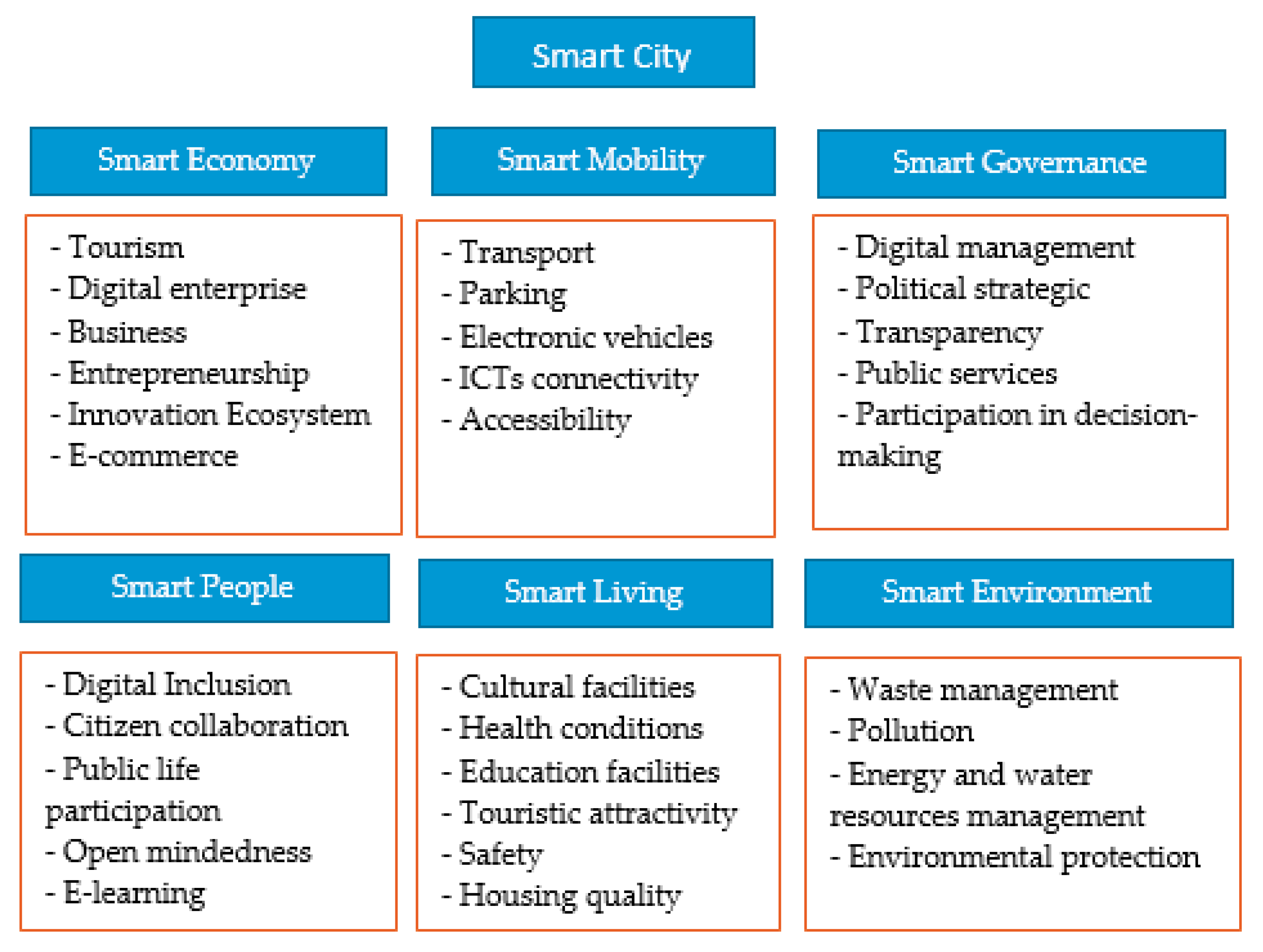



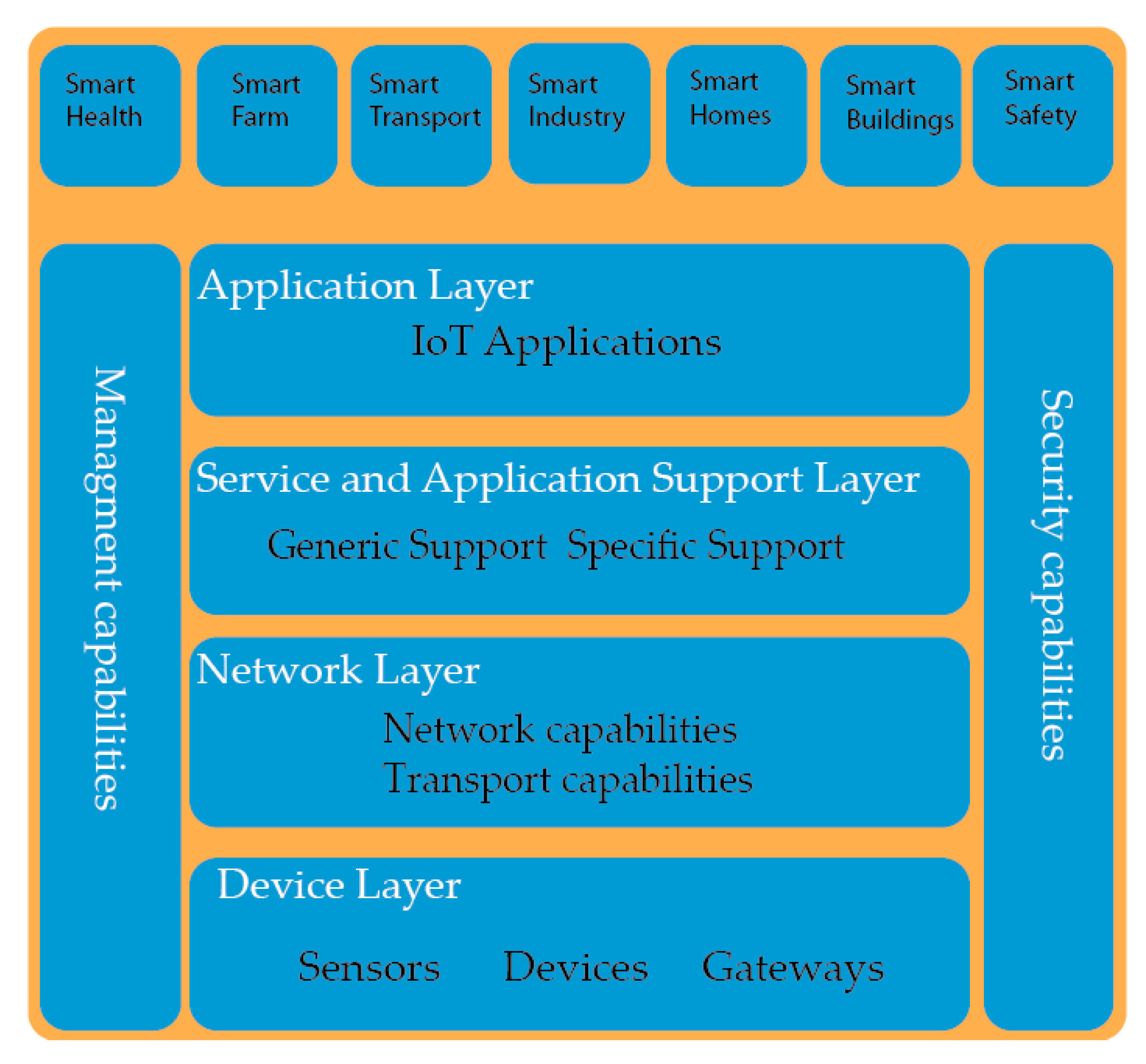
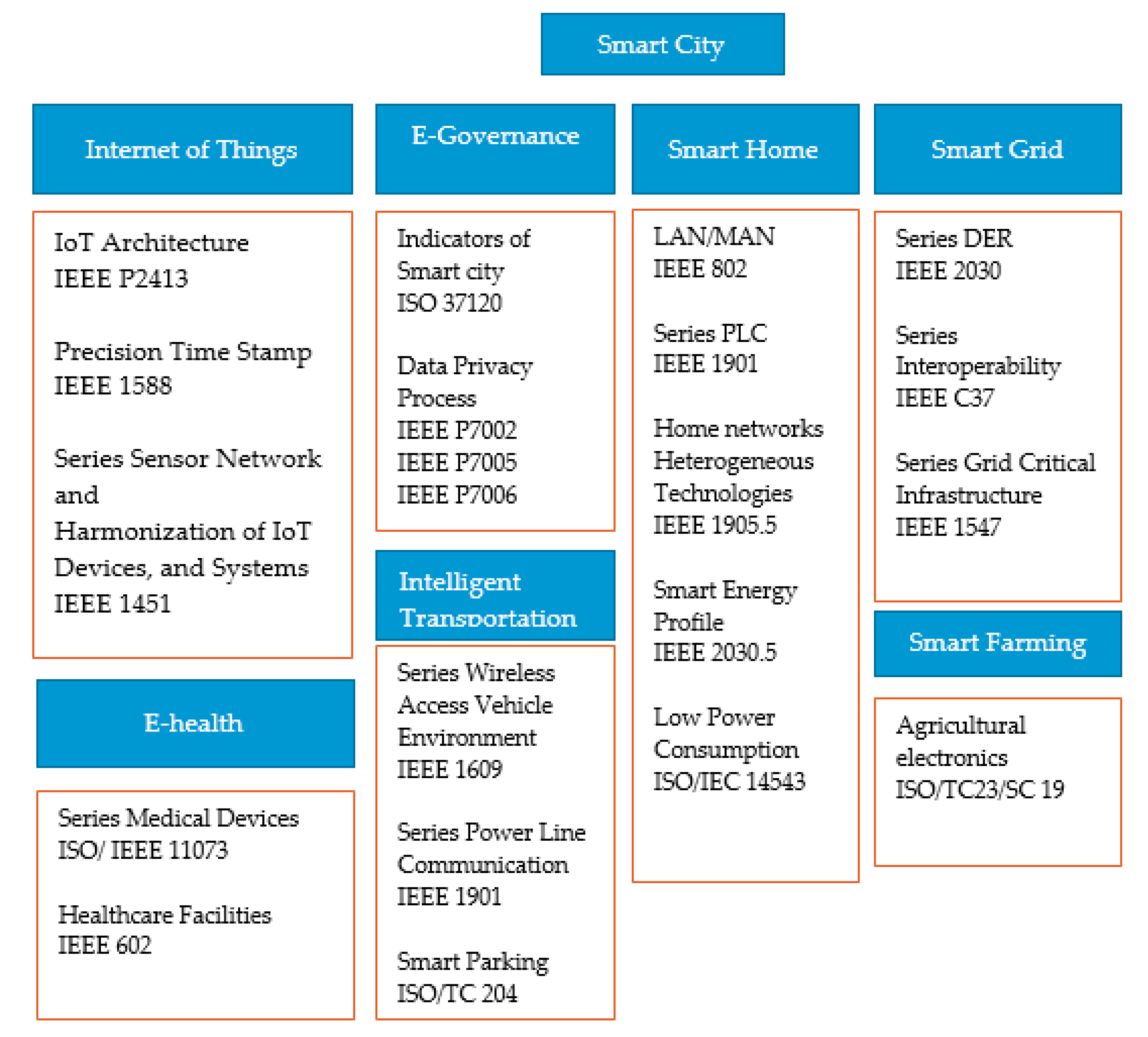
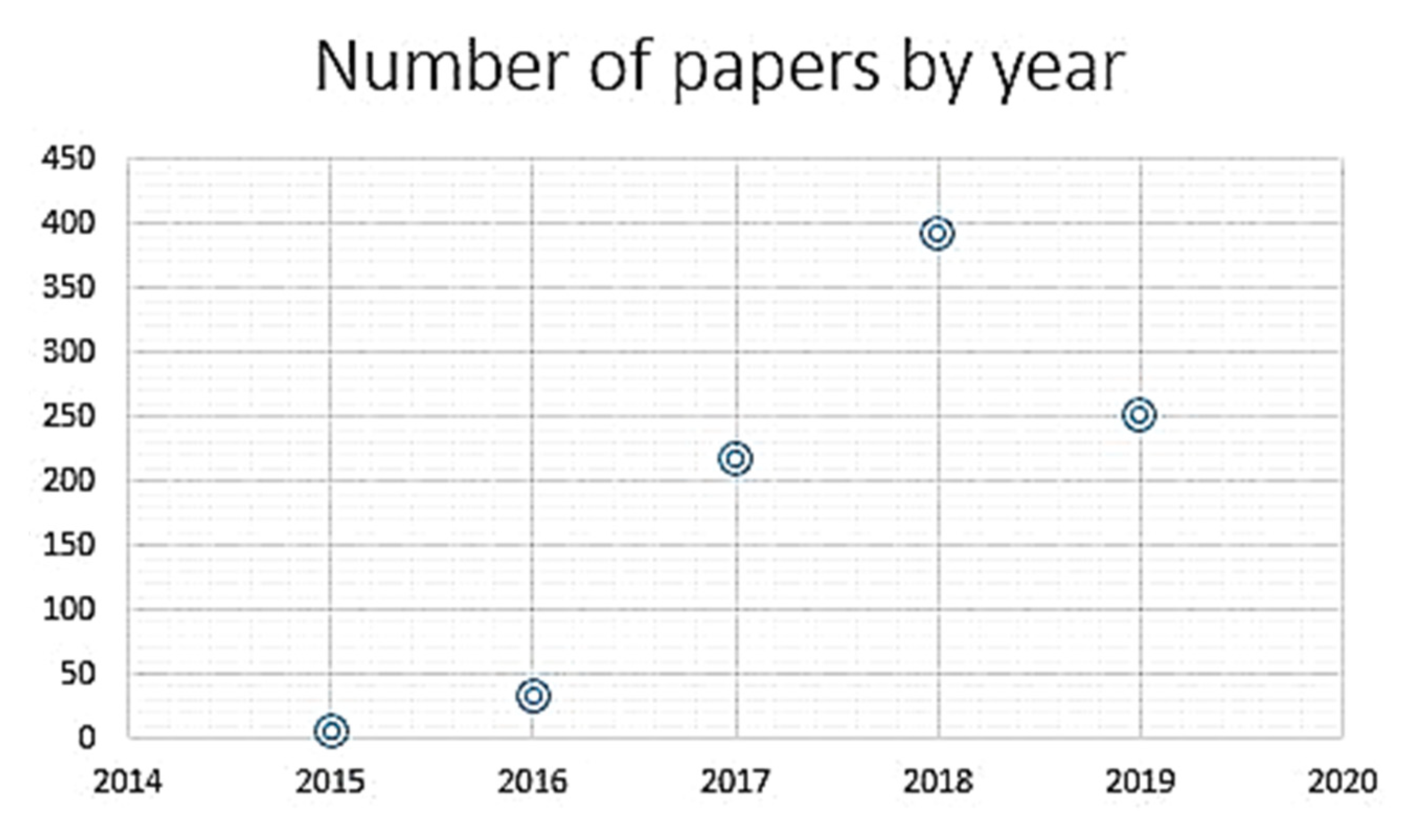
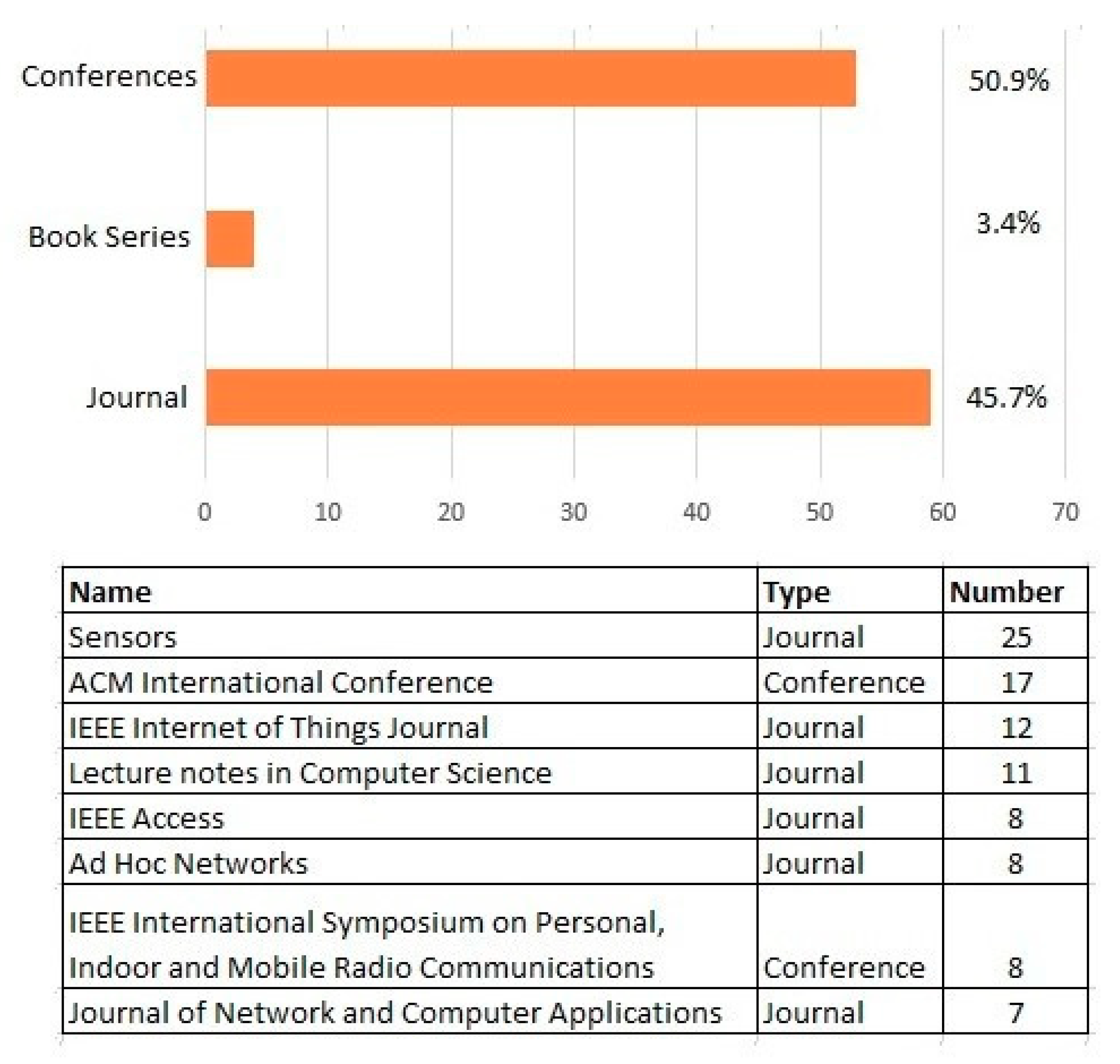

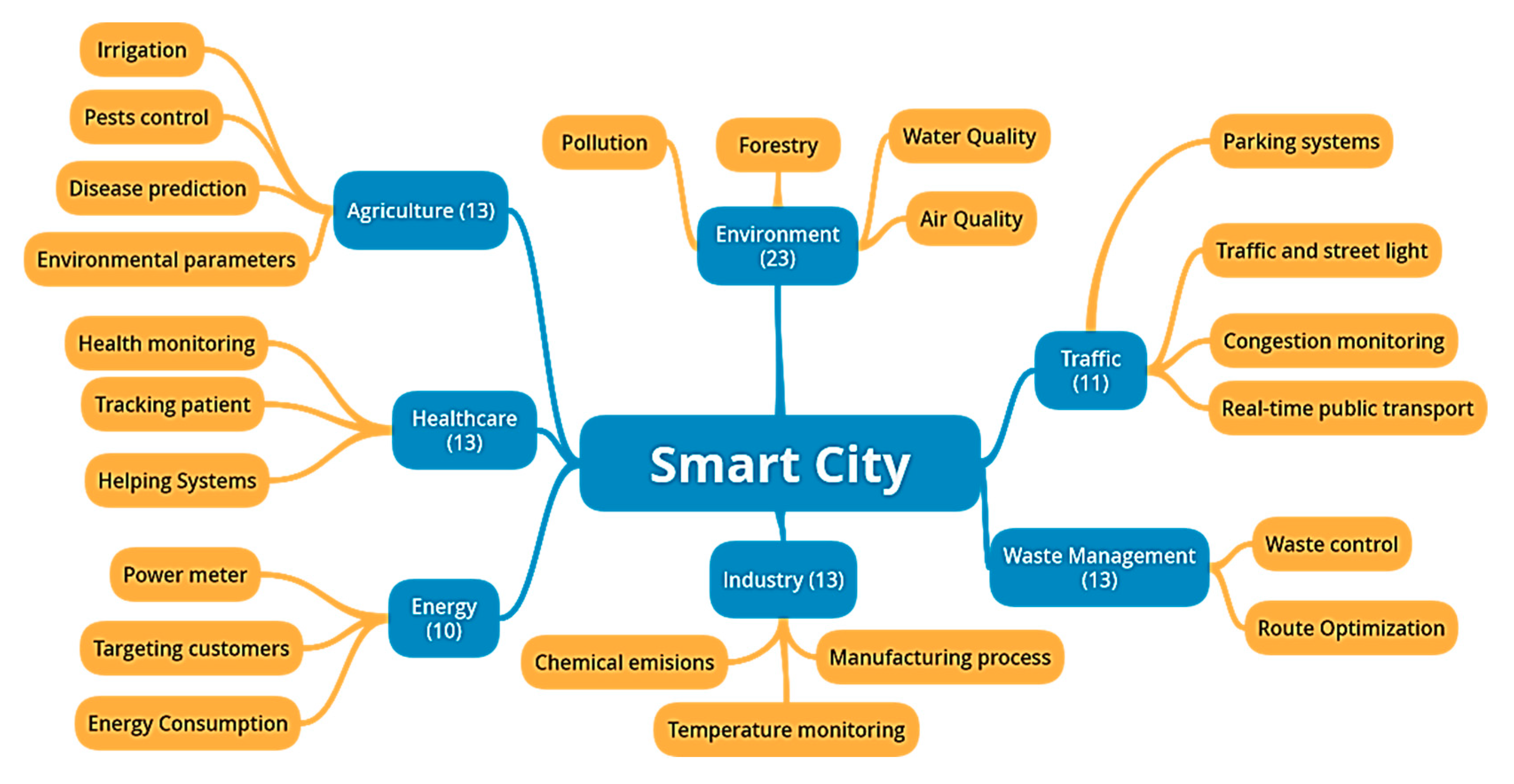
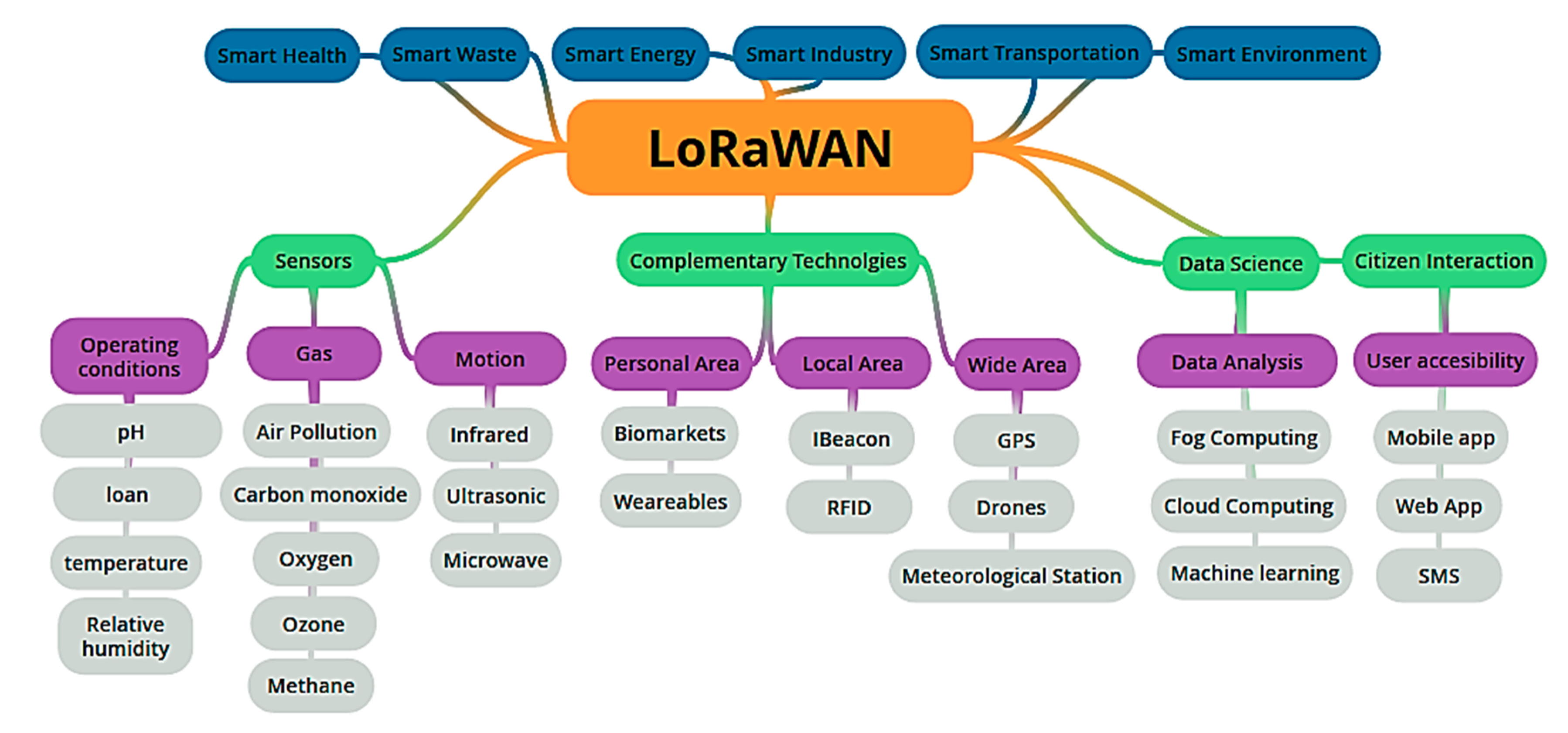
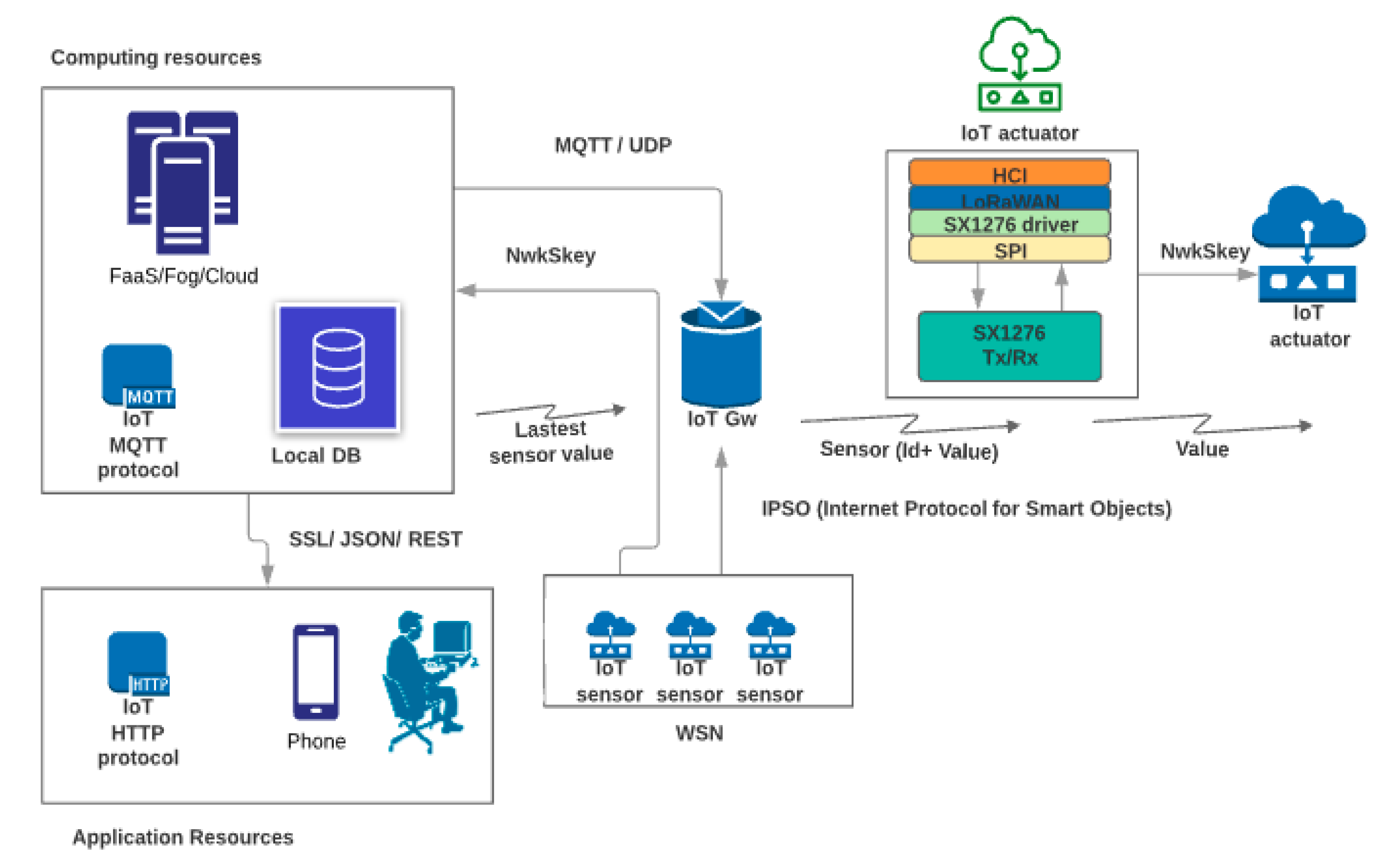


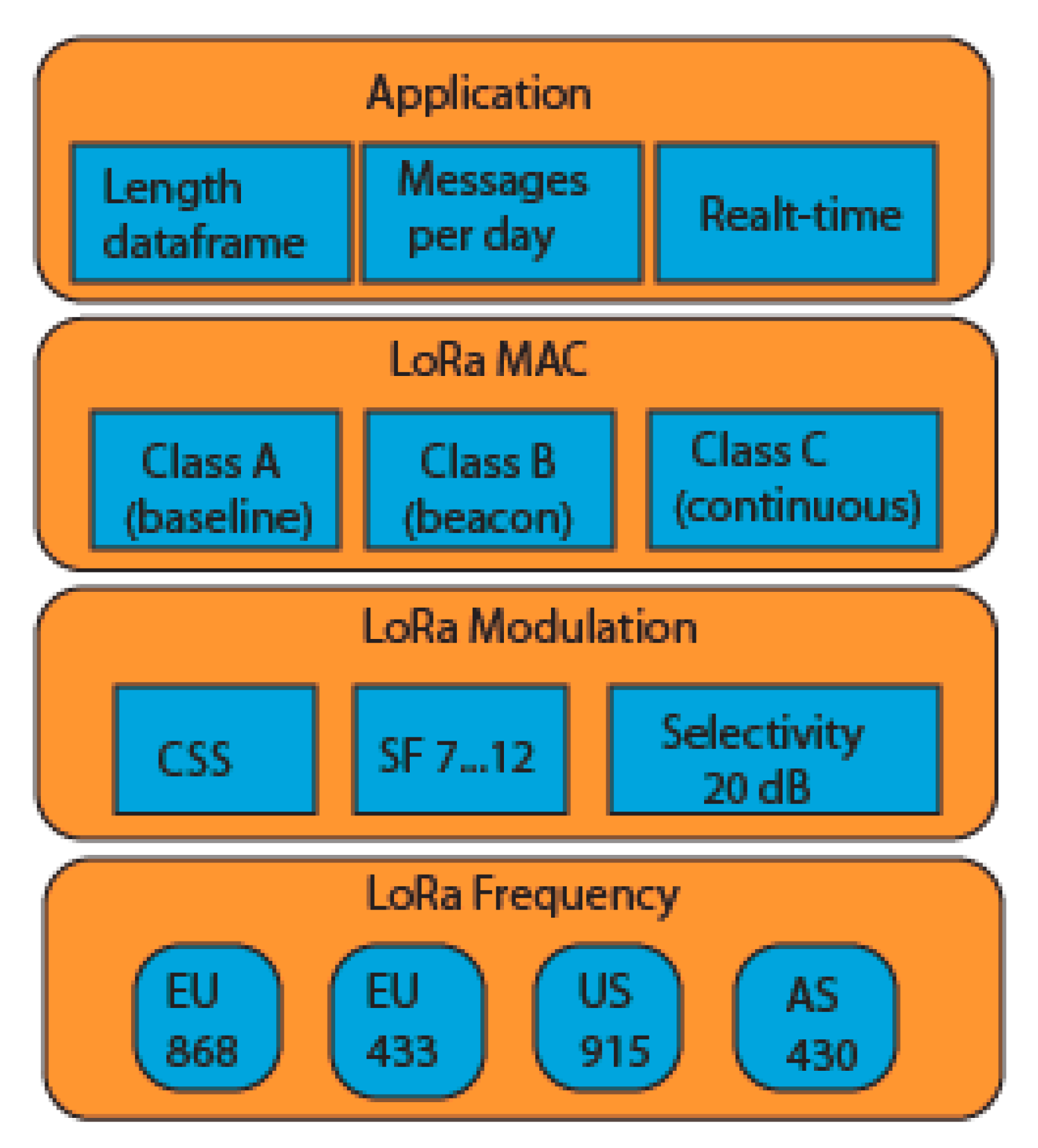

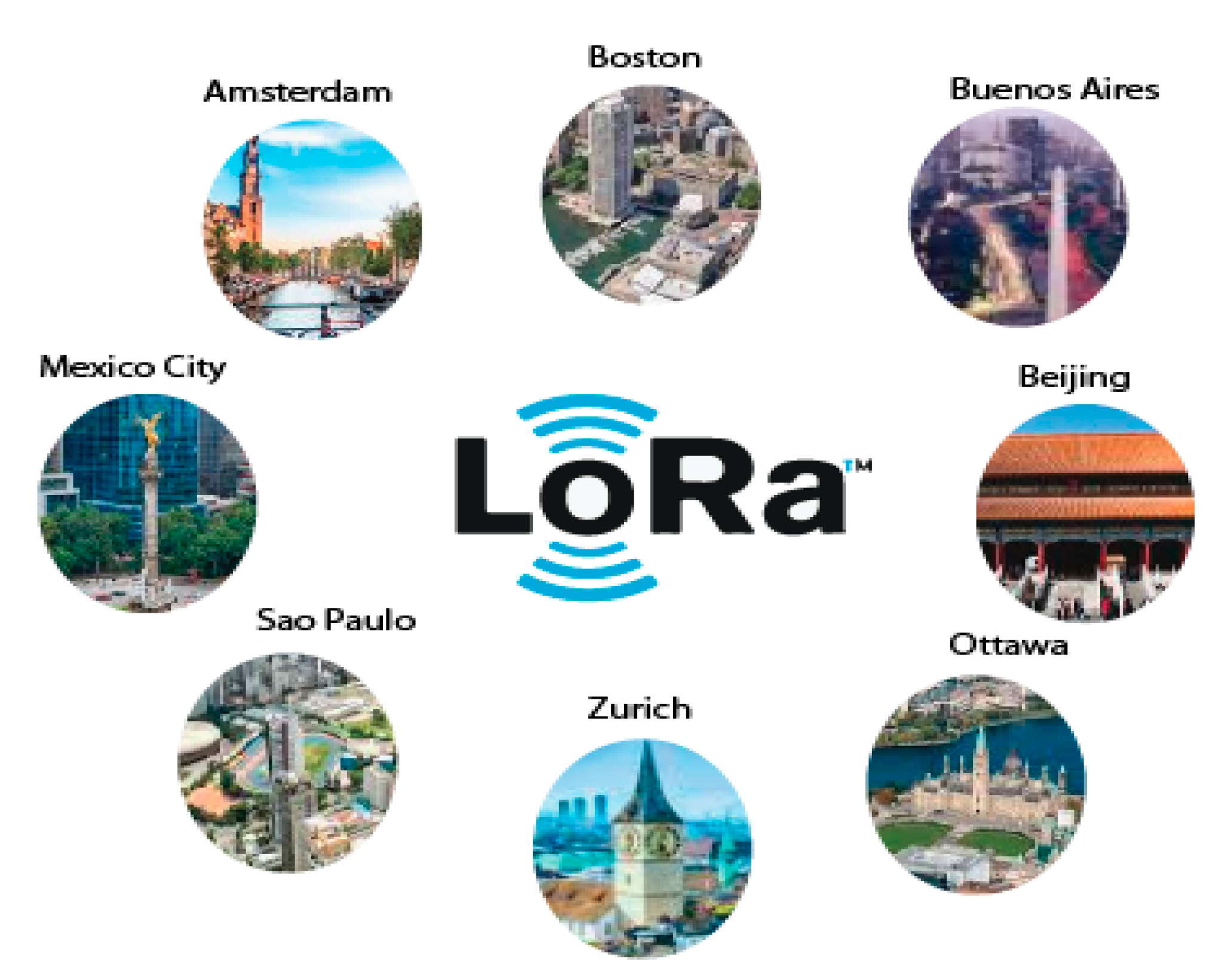



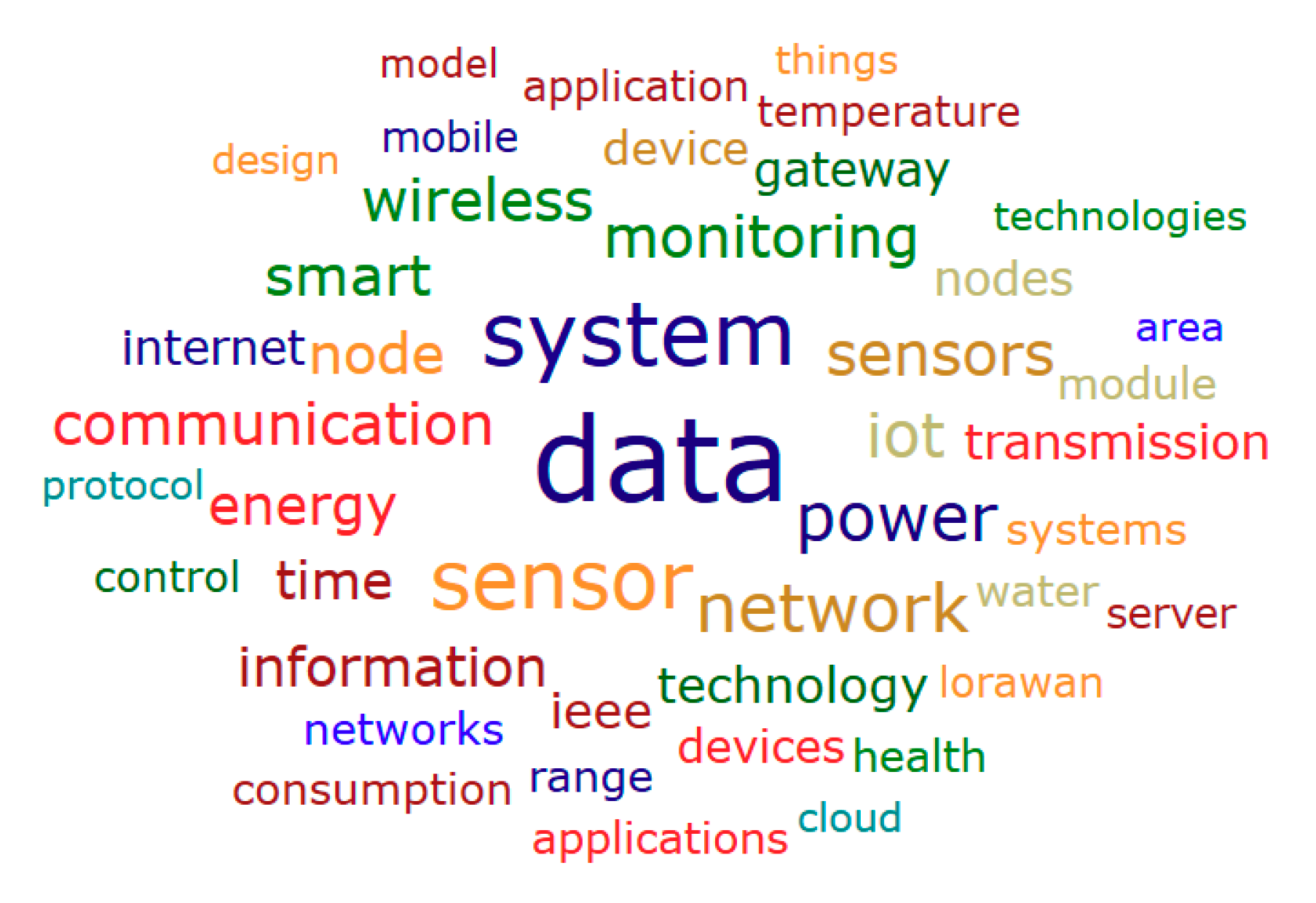
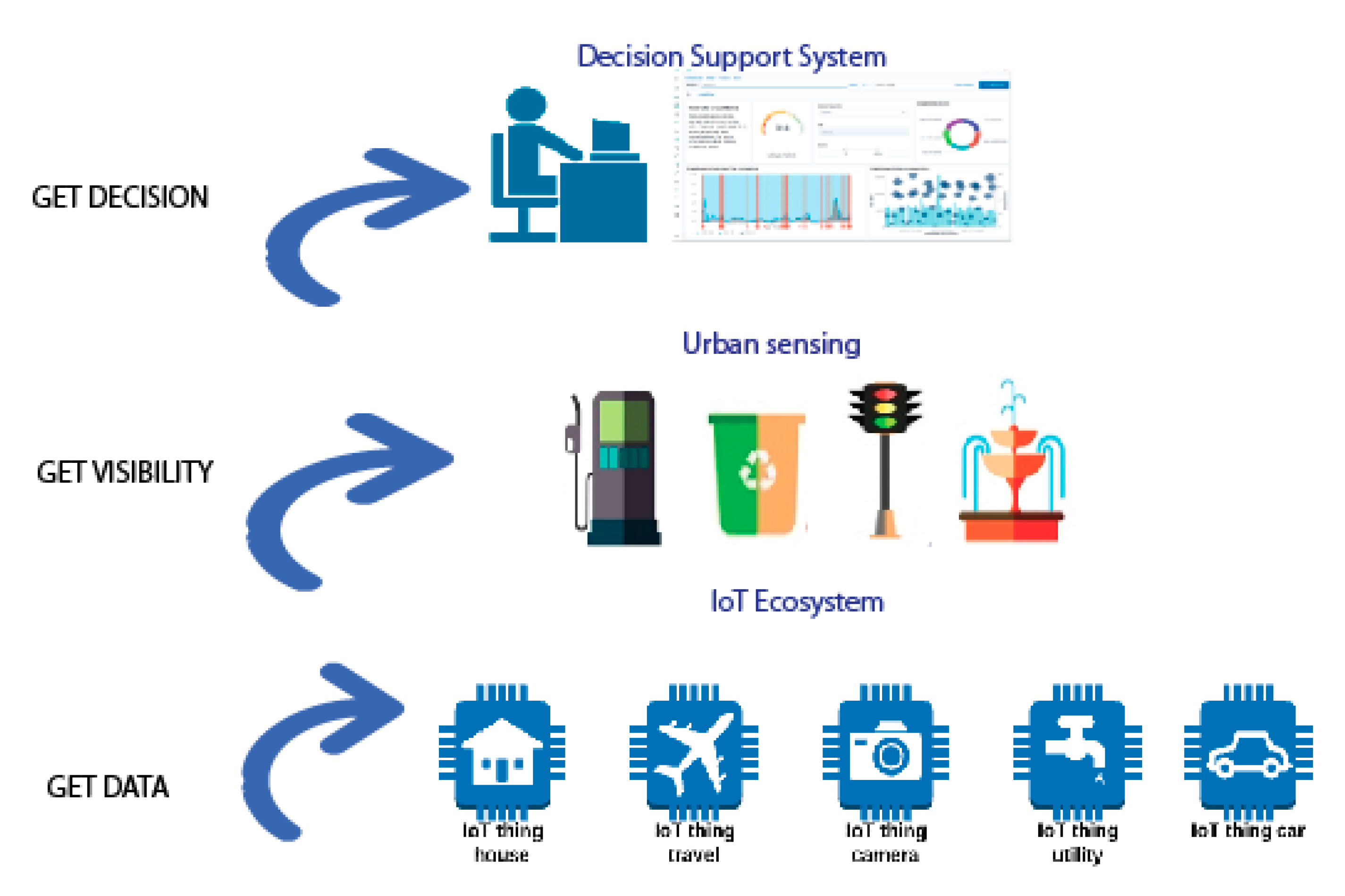
| Criteria of Circularity | Indicator of Circularity |
|---|---|
| Reuse of old buildings | Number of existing reused buildings |
| Energy efficiency | % of energy reduction in buildings |
| Greenhouse gas emissions avoided | % CO2 emissions avoided (tons/year) |
| Water consumption avoided | % of water use reduction in buildings |
| Waste avoided in the construction | % of waste reused |
| Smart City Subcategory | 2015 | 2016 | 2017 |
|---|---|---|---|
| Healthcare | 9.7 | 15 | 23.4 |
| Public Services | 97.8 | 126.4 | 159.5 |
| Smart buildings | 206.2 | 354.6 | 648.1 |
| Smart homes | 294.2 | 586.1 | 1.067 |
| Transport | 237.2 | 298.9 | 371 |
| Journal | Numbers of Papers |
|---|---|
| Sensors | 22 |
| Association for Computing Machinery International Conference | 17 |
| IEEE Internet of Things Journal | 12 |
| Ad Hoc Networks | 8 |
| IEEE Access | 8 |
| Pollutants | Health Disease |
|---|---|
| NO2 | Lung damage |
| CO | Respiratory and hearth diseases |
| PM 2.5 | |
| PM10 | |
| SO2 | Asthma |
| O3 |
| Data Rate | Spread Factor | Bandwidth (KHz) | Throughput (bps) | Payload (Bytes) |
|---|---|---|---|---|
| DR6 | SF7 | 250 | 11,000 | 230 |
| DR5 | SF7 | 125 | 5470 | 230 |
| DR4 | SF8 | 125 | 3125 | 230 |
| DR3 | SF9 | 125 | 1760 | 123 |
| DR2 | SF10 | 125 | 980 | 59 |
| DR1 | SF11 | 125 | 440 | 59 |
| DR0 | SF12 | 125 | 250 | 59 |
| Data Rate | Spread Factor | Bandwidth (KHz) | Throughput (bps) | Payload (Bytes) |
|---|---|---|---|---|
| DR13 | SF7 | 500 | 21,900 | 230 |
| DR12 | SF8 | 500 | 12,500 | 230 |
| DR11 | SF9 | 500 | 7000 | 230 |
| DR10 | SF10 | 500 | 3900 | 230 |
| DR9 | SF11 | 500 | 1760 | 117 |
| DR8 | SF12 | 500 | 980 | 41 |
| DR4 | SF8 | 500 | 12,500 | 250 |
| DR3 | SF7 | 125 | 5470 | 250 |
| Subcategory | Indoor | Outdoor | Object Motion |
|---|---|---|---|
| Agriculture | ● | ● | |
| Healthcare | ● | ● | |
| Energy | ● | ● | |
| Waste Management | ● | ● | |
| Traffic and Transport | ● | ● |
| Subcategory | Communication | Signal Parameters | Observations | Ref |
|---|---|---|---|---|
| Agriculture | Server–Node | @100 m, RSSI = −69 dBm, PDR = 100%, SNR = 6 dB @400 m, RSSI = −100 dBm, PDR < 80%, SNR = 3 dB @700 m, RSSI = −120 dBm, PDR < 41%, SNR = 1 | Decrease of parameters values due to distance and obstacles, e.g., trees. | [59] |
| Healthcare | Diagnostic System–Base station | @1.1 km, RSSI = −127 dBm, PDR = 100%, SNR = −17.2 dB @3.8 km, RSSI = −121 dBm, PDR < 80%, SNR = −16 dB @5.5 km, RSSI = −109 dBm, PDR < 41%, SNR = 1.1 dB | LoRa transmission can generate delays in sending information. Therefore, it is not recommended in real-time applications. Movement of patients can be in low-coverage areas, but it can cause loss of the connectivity signals. | [57] |
| Tracking movement | RSSI = −83.83 dB, | [60] | ||
| Traffic | Streetlights | @50 m, RSSI = −34 dBm, PDR = 100%, SNR = −17.2 dB @250 m, RSSI = −110 dBm, PDR = 100%, SNR = −17.2 dB | Optimal distance between streetlights is around 35 m. This situation requires a large number of sensors. | [37] |
| iBeacon user localization | RSSI = −95 @ −99 dBm | An abnormal RSSI value is <−70 dBm. This situation allows to identify empty slots or determine user location. | [46] | |
| Parking slot occupancy | RSSI = −80 dBm | Difference between empty and occupied slots is near 12 dB. Transient events >−90 dBm | [39] |
| Subcategory | Sensing Parameters | Type of Sensors | Distance GW-Sensor | Ref |
|---|---|---|---|---|
| Agriculture | Humidity, Temperature, Luminosity, Solar radiation, Soil, Conductivity, Ph | Ultrasonic Temperature Humidity Soil | 30 cm–15 km | [22,63,64,65,66] |
| Healthcare | Health signs | Biosensors | 3 m | [61] |
| Energy | Light intensity Motion Voltage Temperature Humidity | Temperature Humidity Motion | 15 km | [18,37] |
| Traffic | Motion Occupancy | Magnetic Ultrasonic | 500 m–1 km | [41,42] |
| Environment | CO2, NO2, O3 Concentration Weather | Gas Temperature | 200 cm–5 km | [27,67,68] |
| Subcategory | Range |
|---|---|
| Voltage | 2.2 V to 5 V |
| Amperes | Temperature sensor: 0.84 mA |
| Light sensor: 0.56 mA | |
| Accelerometer: 4.68 mA | |
| PIR: 0.75 mA | |
| Gas sensor: 4 mA—20 mA | |
| Infrared sensor: 5.5 mA | |
| Flex Sensor: 20 mA | |
| Standards | IEC-61724, IEEE 1451 |
| Byte | Information into Bits Groups |
|---|---|
| First Byte | The entire part of relative humidity. |
| Second Byte | The decimal part of relative humidity. |
| Third Byte | The entire part of temperature. |
| Fourth Byte | The decimal part of temperature. |
| Fifth Byte | Checksum of all previous bytes. |
| DTH11 | DTH22 |
|---|---|
| Temperature measured between 0 and 50 °C | Temperature measured between −40 and 125 °C |
| Temperature measure accuracy 2 °C | Temperature measure accuracy 0.5 °C |
| Humidity measured 20% to 80% | Humidity measured 0% to 100% |
| Humidity measure accuracy 5% | Humidity measure accuracy 2–5% |
| Samples frequency 1 Hz | Samples frequency 2 Hz |
| Voltage 3.5 V a 5 V | Voltage 3.3 V a 6 V |
| Amperes consumed 2.5 mA | Amperes consumed 0.3 mA |
| Smart City | IoT Applications in Smart Cities |
|---|---|
| Buenos Aires | Buenos Aires uses IoT to monitor parameters such as energy consumption, water level in reservoirs, and environmental conditions in 40 schools in the city. Another project is focused on measuring the flow of rivers to avoid flooding in nearby towns. Additionally, Buenos Aires makes use of IoT to create a scalable lighting system to make the city safer, more sustainable, and energy-efficient and to reduce light pollution [80,81]. |
| Amsterdam | Amsterdam has developed projects that use IoT focused on solving traffic-related problems by installing sensors that monitor the state of traffic flow and parking availability. Such solutions have reduced the time of searching available parking lots by 43% [82]. |
| Sao Paulo | Brazil has 400,000 connected devices and invests around 25 percent of Brazilian GDP. Several cities in Brazil, including Sao Paulo, have promoted the development of applications for the measurement of electrical energy, irrigation systems for farms, and sensorization of street lighting systems [83]. |
| Zurich | Zurich considers the use of IoT-LoRa for projects such as (a) no bike left (to recover abandoned bikes), (b) detection of power distribution grid failure, and (c) real-time occupancy rate monitoring in public transportation [84]. |
| Ottawa | In 2009, the city of Ottawa launched a digital storefront using a sensor structure. In addition, the city works with the Centre for Excellence in Next-Generation Networks (CENGN) to accelerate the inclusion of ICT in the city. CENGN provides an LPWAN infrastructure (i.e., an antenna and a gateway) to develop smart health, smart farming, and other applications [85,86]. |
| Beijing | Beijing invests around $5 billion in IoT projects related to transportation and environmental management. Beijing’s Palace Museum uses IoT solutions to detect the movement of relics that may be associated with a robbery. Another problem that the city of Beijing seeks to solve with the use of IoT and cognitive computing is the reduction of smoke in the environment by installing several sensors to determine the sources of pollution [87]. |
| Boston | Boston works on smart city projects related to autonomous vehicles, intelligent parking lots, and interactive public art. The city uses cameras and sensors to learn how people navigate and interact with the city streets of Boston [88]. |
| Mexico | Mexico City seeks to strengthen the domains of governance, public management, and transportation. Mexico City tries to solve transportation and traffic problems by determining car flow patterns and delivering information of available parking spaces [89]. |
| Subcategory | Verizon | Growth Enabler | IoT Analytics |
|---|---|---|---|
| Manufacturing/Industry | 84% | 20% | 17% |
| Energy | 41% | 18% | 10% |
| Transportation | 40% | 7% | 11% |
| Healthcare | 11% | 20% | 6% |
| Strengths | Weakness |
|---|---|
|
|
| Opportunities | Threats |
|
|
| Loose Integration | Tight Integration | Data | Total | |
|---|---|---|---|---|
| Agriculture and Farming | 1 | 0 | 12 | 13 |
| Energy | 2 | 3 | 5 | 10 |
| Environment | 10 | 2 | 11 | 23 |
| Healthcare | 8 | 0 | 5 | 13 |
| Industry | 6 | 1 | 6 | 13 |
| Transportation | 3 | 3 | 5 | 11 |
| Waste Management | 3 | 3 | 7 | 13 |
| Total of paper | 33 | 12 | 51 | 96 |
| % Papers | 34% | 13% | 53% |
| Loose Integration | Tight Integration | Data | |
|---|---|---|---|
| Agriculture and Farming | 2.7 | 1.6 | 3.8 |
| Energy | 0.6 | 2.5 | 0.0 |
| Environment | 0.6 | 0.3 | 0.1 |
| Healthcare | 2.8 | 1.6 | 0.5 |
| Industry | 0.5 | 0.2 | 0.1 |
| Transportation | 0.2 | 1.9 | 0.1 |
| Waste Management | 0.5 | 1.2 | 0.0 |
| Social | Economic | Organizational | Material Reuse | |
|---|---|---|---|---|
| Agriculture and Farming | 3 | 1 | 7 | 2 |
| Energy | 1 | 4 | 2 | 3 |
| Environment | 16 | 2 | 4 | 1 |
| Healthcare | 7 | 0 | 4 | 2 |
| Industry | 0 | 7 | 3 | 3 |
| Transportation | 4 | 1 | 6 | 0 |
| Waste Management | 4 | 0 | 2 | 7 |
© 2019 by the authors. Licensee MDPI, Basel, Switzerland. This article is an open access article distributed under the terms and conditions of the Creative Commons Attribution (CC BY) license (http://creativecommons.org/licenses/by/4.0/).
Share and Cite
Andrade, R.O.; Yoo, S.G. A Comprehensive Study of the Use of LoRa in the Development of Smart Cities. Appl. Sci. 2019, 9, 4753. https://doi.org/10.3390/app9224753
Andrade RO, Yoo SG. A Comprehensive Study of the Use of LoRa in the Development of Smart Cities. Applied Sciences. 2019; 9(22):4753. https://doi.org/10.3390/app9224753
Chicago/Turabian StyleAndrade, Roberto Omar, and Sang Guun Yoo. 2019. "A Comprehensive Study of the Use of LoRa in the Development of Smart Cities" Applied Sciences 9, no. 22: 4753. https://doi.org/10.3390/app9224753
APA StyleAndrade, R. O., & Yoo, S. G. (2019). A Comprehensive Study of the Use of LoRa in the Development of Smart Cities. Applied Sciences, 9(22), 4753. https://doi.org/10.3390/app9224753






